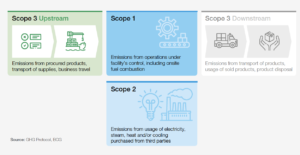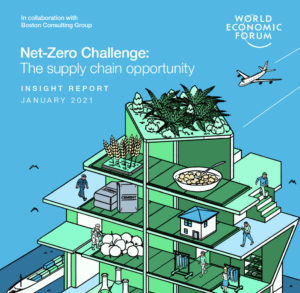WEF, co-authored with Boston Consulting Group, published a report for the Net-Zero Challenge: The supply chain opportunity. It showcases the opportunity that all companies have for huge climate impact through action to decarbonize global supply chains. Addressing supply-chain emissions enables many customer-facing companies to impact a volume of emissions several times higher than they could if they were to focus on decarbonizing their own direct operations and power consumption alone.
Findings
Many companies can multiply their climate impact by decarbonizing supply chains. For companies in most customer-facing sectors, end-to-end emissions are much higher than the direct emissions in their own operations. By engaging suppliers to create a net-zero supply chain, companies can boost their climate impact, enable emission reduction in hard-to-abate sectors, and accelerate climate action in countries where it would otherwise not be high on the agenda.
Eight supply chains account for more than 50 percent of global emissions. Food, construction, fashion, fast-moving consumer goods, electronics, automotive, professional services, and freight account for more than half of all global greenhouse gas emissions. A significant share is indirectly controlled by only a few companies.
Net-zero supply chains would hardly increase end-consumer costs. Around 40% of all emissions in these supply chains could be abated with readily available and affordable levers (<€10 per tonne of CO2 equivalent), such as circularity, efficiency, and renewable power – with only marginal impact on product costs. Even with zero supply-chain emissions, end-consumer costs would go up by 1 to 4 percent at the most in the medium term.
Decarbonizing supply chains is hard
Even leading companies struggle to get the data they need and to set clear targets and standards to which their suppliers must adhere. Engaging an often fragmented supplier landscape is challenging – especially when emissions are “buried” deep in the supply chain, or when addressing them might require collective action at the industry level.
Through interviews with several dozen global companies that lead the way in reducing supply-chain emissions, WEF has identified key actions:
- build a comprehensive emissions baseline, gradually filled with actual supplier data;
- set ambitious and holistic reduction targets, reducing emissions by revisiting product design choices and reconsidering (geographic) sourcing strategy;
- set ambitious procurement standards and work jointly with suppliers to co-fund abatement levers;
- work together with peers to align sector targets that maximize impact and level the playing field;
- use scale by driving up demand to lower the cost of green solutions;
- develop internal governance mechanisms that introduce emissions as a steering mechanism and align the incentives of decision-makers with emission targets.
Source: WEF


